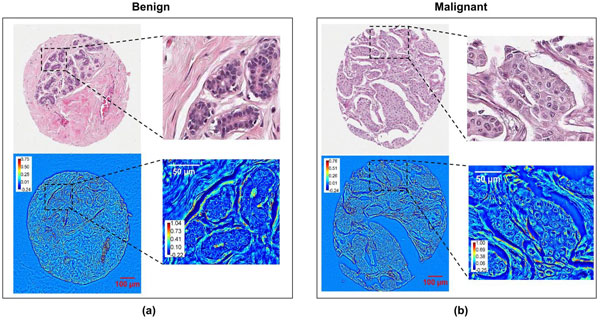Spatial light interference microscopy (SLIM) might provide a quantitative way to diagnose breast cancer.
Researchers at the University of Illinois recently used data-based SLIM assessment to determine whether breast tissue biopsies from 400 patients contained benign or malignant cells. The results agreed 88 and 87 percent of the time with the findings of two histopathologists who assessed the same samples using hematoxylin and eosin stains.
The unstained samples were analyzed using a SLIM module attached to a commercial phase contrast microscope to generate interferograms — photographic images derived from how the tissue refracts light.

A comparison of stained brightfield microscopy (top row) and SLIM (bottom row) images and their respective abilities to show malignant and benign lesions. The images were obtained from adjacent sections. Color bars are in radians. Courtesy of Hassaan Majeed et al., University of Illinois/SPIE.
Four interferograms were used to produce one quantitative image showing areas with different refractive properties in different colors. The boundary between tumors and the cells around them were clearly delineated, making it possible to assess whether the tumors were malignant or benign.
Because the SLIM method is based on quantitative data rather than subjective assessment, the researchers said it could become the basis for an automated image analysis system that would provide a fast and accurate diagnostic method.
Today when an abnormality in the breast is discovered, standard practice is for the physician to take a tissue biopsy, which is then stained to provide enough contrast for a pathologist to study key features of the tissue under a microscope.
Due to variations such as staining intensity and the illumination used, the process does not lend itself to automation. Meanwhile, such manual inspections are subject to investigator bias, and the process is time-consuming. This can, in some cases, result in late diagnosis — a critical shortcoming given that early diagnosis significantly improves chances of survival.
The research was published in the Journal of Biomedical Optics (doi: 10.1117/1.JBO.20.11.111210).